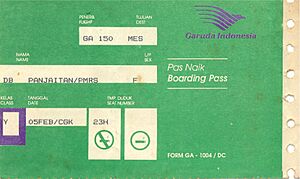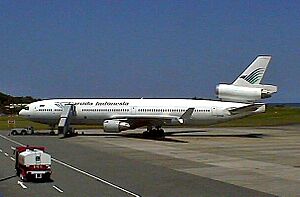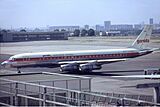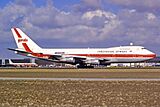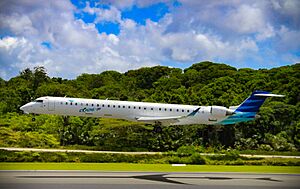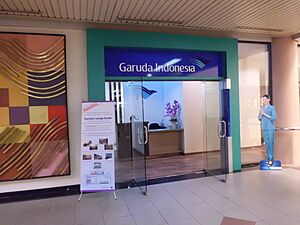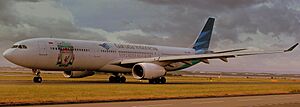Garuda Indonesia facts for kids
A Garuda Indonesia Airbus A330
|
|
| Founded | 1 August 1947 (as KLM Interinsulair Bedrijf ) |
|---|---|
| Commenced operations |
|
| Hubs | Jakarta–Soekarno-Hatta |
| Secondary hubs |
|
| Focus cities | Surabaya |
| Frequent-flyer program | GarudaMiles |
| Alliance | SkyTeam |
| Subsidiaries |
|
| Fleet size | 83 |
| Destinations | 52 |
| Parent company |
|
| Headquarters | Garuda City Center Building Complex M1 Street, Soekarno–Hatta International Airport, Tangerang, Banten, Indonesia |
| Key people | |
| Revenue | |
| Operating income | |
| Net income | |
| Total assets | |
| Employees | |
Garuda Indonesia is Indonesia's main airline. It is based at Soekarno–Hatta International Airport near Jakarta. The airline is part of the SkyTeam group of airlines. It is the second-largest airline in Indonesia, flying to many places in Asia, Europe, and Australia. Garuda Indonesia is the only Indonesian airline that flies to Europe.
In the late 1980s and early 1990s, Garuda flew to many cities worldwide. This included places like Los Angeles, Paris, and Rome. However, in the late 1990s and early 2000s, the airline faced money problems. This made them cut back on many flights.
In 2009, Garuda started a big plan called Quantum Leap. This plan changed the airline's look, including its logo and uniforms. They also bought newer planes and focused on international flights again. This helped Garuda win awards like "Most Improved Airline" and "World's Best Cabin Crew" from Skytrax. Even though the airline has faced financial challenges since then, it has kept its good service and safety. New leaders took over in 2020 and started a new plan to fix the airline's money issues.
Garuda also had a budget airline called Citilink. Citilink offered cheaper flights to many places in Indonesia. It became a separate company in 2012.
Contents
A Look Back: Garuda's Journey
Starting Up (1949–1960s)

Garuda Indonesia started from an airline called KLM Interinsulair Bedrijf. This airline became part of Indonesia in December 1949.
Garuda Indonesia's story began during Indonesia's fight for independence in the late 1940s. At that time, Garuda flew special missions using a Douglas DC-3 plane. This first plane was called Seulawah, which means "Gold Mountain" in Acehnese. It was bought with money given by the people of Aceh.
The first commercial flight was on January 26, 1949. It flew from Calcutta to Yangon using a DC-3 Dakota plane. This date is usually seen as the airline's birthday.

The name Garuda comes from an old Hindu story. Garuda is a mythical bird that Lord Vishnu rides. Indonesia's first President, Sukarno, suggested the name in 1949. The first flight under the name Garuda Indonesian Airways happened on December 28, 1949. It was to pick up President Sukarno in Yogyakarta.
In the early to mid-1950s, Garuda had 38 planes. These included 22 DC-3s and 8 Convair 240s. In 1956, the airline flew its first flight to Mecca, carrying Indonesian pilgrims.
Garuda's fleet grew in the 1960s. In 1961, they got three Lockheed L-188 Electra planes. In 1963, they received their first jet plane, the Convair 990 Coronado. This allowed them to start flights to Hong Kong.
In 1965, Garuda received its first Douglas DC-8. This helped them fly beyond Asia. They started regular flights from Kemayoran Airport to Amsterdam and Frankfurt. They also began flights to Rome and Paris. That same year, Garuda started flights to China, becoming the first Indonesian airline to do so.
Growing Bigger (1970s–1990s)

In the early 1970s, Garuda started using McDonnell Douglas DC-9 and Fokker F28 Fellowship planes for shorter flights. Garuda became the biggest user of the F28, with 62 of them. In 1976, Garuda got its first McDonnell Douglas DC-10. This plane could carry more passengers and fly longer distances. In 1980, the airline received its first Boeing 747-200. This plane was used for routes with many passengers or long distances.
In 1982, Garuda was the first airline to use the Airbus A300 B4-220FFCC. This was a special version that needed only two pilots instead of three. By 1984, Garuda had a large fleet of different planes. In 1985, Garuda changed its logo and look. This project was expensive but helped improve Garuda's image as the national airline.
Garuda also increased the number of flights and places it flew to. It lowered ticket prices and worked with another Indonesian airline, Merpati Nusantara Airlines.
In 1991, Garuda received McDonnell Douglas MD-11 planes. These planes helped them fly to Los Angeles. During this time, Garuda flew to many places in Asia, Europe, and North America. In 1994, Garuda got its first Boeing 747-400. In 1996, the first Airbus A330-300 arrived. This plane was more fuel-efficient.
Tough Times (1996–2009)
The late 1990s and early 2000s were very hard for Garuda. The airline faced many problems, including financial difficulties. This led to a big reduction in flights. They stopped flying to the Americas and greatly reduced flights to Europe. Garuda kept flying to Amsterdam because of historical connections with the Netherlands.
The airline also faced a difficult period due to a serious incident involving a passenger in 2004. This led to legal issues and damaged its reputation.
In June 2007, the European Union (EU) stopped Garuda Indonesia and other Indonesian airlines from flying to Europe. This happened after a plane crash earlier that year. The EU later reviewed its decision. In July 2009, the ban was lifted. After this, Garuda started planning flights to Amsterdam and other European cities again.
New Beginnings (2009–2020)
After the EU ban was lifted, Garuda announced a big five-year plan called Quantum Leap in July 2009. This plan aimed to improve the airline's image. It included changing the plane designs, staff uniforms, and logo. The plan also aimed to almost double the number of planes and increase passenger numbers.
As part of Quantum Leap, the airline updated its logo and redesigned its plane look in 2009. New uniforms were introduced in 2010. In 2011, Garuda opened a new main airport hub in Makassar to serve eastern Indonesia. This was its third hub after Jakarta and Denpasar.
In 2013, Garuda won the Skytrax World's Best Cabin Crew Awards. They won this award again for five years in a row until 2018.
Garuda also added more flights to many international places. These included Singapore, Bangkok, Beijing, and Shanghai.
In 2011, Garuda ordered 25 Airbus A320 planes for its subsidiary, Citilink. The airline also changed its order for Boeing 787 Dreamliner planes to 10 Boeing 777-300ERs. These planes were delivered in 2013 for long-haul flights to Europe and medium-haul flights within Asia.
The airline started selling its shares on the Indonesia Stock Exchange in February 2011. The Indonesian government still owned most of the shares. In late 2014, Garuda became one of only seven airlines to get a 5-star rating from Skytrax. This marked the end of the Quantum Leap program.
After this, the CEO, Emirsyah Satar, retired. The new CEO, Arif Wibowo, started a plan to cut costs and increase income. He canceled flights that were not making money. Despite this, he wanted to continue expanding internationally. In 2015, Garuda announced plans to order 90 new planes from Boeing and Airbus.
COVID-19 Pandemic (2020–2023)
In May 2020, because of the COVID-19 pandemic, Garuda Indonesia had to temporarily stop paying 800 of its staff. In June, they laid off 180 contract pilots. The airline made sure crew members wore face masks to stop the spread of the virus.
Financial Challenges
Because the pandemic lasted a long time, Garuda Indonesia faced big problems with its money and operations. Its debt grew very large. To save the airline, Garuda cut about 30 percent of its staff. The company also said its leaders took a pay cut.
By the end of 2021, Garuda owed $9.8 billion to over 800 creditors. This made it hard to solve the problems outside of court. The government even prepared another airline, Pelita Air Service, to take over if Garuda could not be saved.
In May 2022, Garuda went to court to try and reschedule its debts. The court gave them more time. In June 2022, Garuda announced its debt was $8.3 billion. They promised to be profitable in three years if their creditors agreed to delay payments. On June 17, 2022, most creditors voted to accept Garuda's plan, which helped save the company from going bankrupt.
In September 2022, Garuda Indonesia also filed for US Chapter 15 bankruptcy protection.
How Garuda Works
Leaders of Garuda Indonesia
| Name | From | To |
|---|---|---|
| Dr. E. Konijnenburg | 1950 | 1954 |
| Ir. Soetoto | 1954 | 1959 |
| Marsekal Iskandar | 1959 | 1961 |
| Partono | 1961 | 1965 |
| Soedarmo | 1965 | 1968 |
| Wiweko Soepono | 1968 | 1984 |
| Reyn Altin Johannes Lumenta | 1984 | 1988 |
| Soeparno | 1988 | 1992 |
| Wage Mulyono | 1992 | 1995 |
| Soepandi | 1995 | 1998 |
| Robby Djohan | 1998 | 1999 |
| Abdul Gani | 1999 | 2002 |
| Indra Setiawan | 2002 | 2005 |
| Emirsyah Satar | 2005 | 2014 |
| Muhammad Arif Wibowo | 2014 | 2017 |
| Pahala Nugraha Mansury | 2017 | 2018 |
| I Gusti Ngurah Askhara Danadiputra | 2018 | 2019 |
| Fuad Rizal | 2019 | 2020 |
| Irfan Setiaputra | 2020 | 2024 |
| Wamildan Tsani Panjaitan | 2024 | Present |
Garuda's Look and Design

Garuda Indonesia has changed its look and design many times since it started.
Early Designs
In its very first years, Garuda's planes had a simple "Indonesian Airways" name. They had blue lines and the Indonesian flag on the tail.
1950s Look
Later, in the 1950s, the planes had "Garuda Indonesian Airways" written on them. They had red lines and the Indonesian flag on the tail.
1960s Update
In the 1960s, Garuda started using red and white colors, like the Indonesian flag. They also added a bird logo, a triangle-shaped eagle, on the tail of their planes.
1969 New Look
In 1969, a new style of writing for "Garuda" became the main logo. The planes got a new color scheme with red and orange lines. This design was used until 1985.
1985 Makeover
In 1985, Garuda changed its name to "Garuda Indonesia" and got a completely new look. This new design was made by Landor Associates. The new logo was a Garuda bird with five curved lines for its wings. The colors changed to deep royal blue and aqua. These colors were inspired by Indonesia's green nature and blue seas.
2009 Modern Look
In 2009, Garuda launched another new look, also designed by Landor Associates. This new design was called "nature's wing." The old bird logo from 1985 was kept but with small changes. The new plane design uses blue and aqua shades, inspired by bird wings and water ripples.
Special Plane Designs
To celebrate 62 years of service, in 2011, Garuda painted two of its Boeing 737-800s with old designs from the 1960s and 1970s.
To encourage people to wear masks during the COVID-19 pandemic, Garuda painted five of its planes with a surgical mask design. The planes also had the words "Ayo pakai masker" (meaning "Please wear masks"). This was part of a competition where people designed masks for the planes.
Main Office
Garuda Indonesia's main office is at Soekarno–Hatta International Airport in Tangerang, Indonesia. This building is called the Garuda Indonesia Management Building. The Indonesian President opened this office in 2009. Before that, the main office was in the center of Jakarta.
Garuda's Other Companies
Garuda Indonesia has several smaller companies, called subsidiaries:
| Company | Type | Main activities | Country | Garuda's ownership |
|---|---|---|---|---|
| PT Citilink Indonesia | Subsidiary | Low-cost airline | Indonesia | 100% |
| PT Garuda Maintenance Facility Aero Asia Tbk | Subsidiary | Aircraft maintenance | Indonesia | 100% |
| PT Aero Wisata | Subsidiary | Travel, hotel, transportation and catering services | Indonesia | 100% |
| PT Sabre Travel Network Indonesia (Previously Abacus) | Subsidiary | Computer reservation provider | Indonesia | 100% |
| PT Gapura Angkasa | Subsidiary | Ground handling service | Indonesia | 58,75% |
| PT Aero Systems Indonesia | Subsidiary | IT provider and solutions | Indonesia | 100% |
| Cargo Garuda Indonesia | Strategic Business Unit | Cargo | Indonesia | 100% |
| Garuda Sentra Medika | Strategic Business Unit | Aircrew health services | Indonesia | 100% |
| PT Aerojasa Perkasa | Strategic Business Unit | Cargo | Indonesia | 100% |
| Garuda Indonesia Holiday France S.A.S. | Subsidiary | Travel agency | Indonesia, France | 100% |
In 2019, Garuda Indonesia launched a new company called PT Garuda Tauberes Indonesia. This company handles logistics, like courier services and payments through an online shopping app.
Working with Others
On August 18, 2018, Garuda Indonesia signed an agreement with the cargo airline Jayawijaya Dirgantara. This was to help distribute cargo from Jayapura to Wamena.
Where Garuda Flies

Garuda Indonesia flies to 96 airports. This includes 72 places in Indonesia and 24 international destinations in 12 countries. They have about 500 flights every day from their main airports in Jakarta, Denpasar, Makassar, and Medan. The airline flies to Asia, Australia, and Europe. Some of its destinations include Singapore, Shanghai, Tokyo, Amsterdam, and Sydney.
In June 2008, Garuda Indonesia increased flights between Australia and Bali. This was because more Australians were traveling to Bali.
On October 13, 2009, Garuda announced it would start flying to Europe again. Flights between Jakarta and Amsterdam began in June 2010. After getting its Boeing 777-300ER planes in 2013, the airline started non-stop flights to Amsterdam. This was Garuda's longest flight. On September 8, 2013, the Amsterdam flight was extended to London.
In 2011, Garuda flew 17.1 million passengers. This was a big increase from the year before. Most of these passengers were on domestic flights within Indonesia.
On March 31, 2016, Garuda Indonesia started its first flight from Singapore Changi Airport to London Heathrow. They used a Boeing 777-300ER for this route.
In mid-2016, Garuda planned to restart flights to Mumbai from Jakarta. This service started on December 12, 2016, with a stop in Bangkok.
In September 2016, Garuda Indonesia announced plans to fly to Los Angeles again. This would be via Tokyo–Narita using a Boeing 777-300ER. The plan was to start in November 2017. However, as of August 2025, this flight has not started.
In February 2017, Garuda Indonesia announced it would resume flights to Dubai and Moscow. These flights were planned for 2018 but have not yet started as of August 2025.
In August 2018, Garuda Indonesia announced it would stop flights to London Heathrow by October. However, they resumed these flights in December of the same year. In 2019, Garuda changed the London route to fly from Jakarta to London Heathrow, then from London Heathrow to Denpasar.
Working with Other Airlines
Garuda Indonesia works with other airlines through agreements called codeshares. This helps them offer more flights to places like Western Europe and the Middle East. In 2009, Garuda Indonesia wanted to join the SkyTeam group of airlines. This would connect SkyTeam's network to Indonesia, Australia, and New Zealand. On March 5, 2014, Garuda Indonesia officially became the 20th member of the SkyTeam alliance.
Outside of SkyTeam, Garuda Indonesia has worked with many airlines over the years. For example, in 2007, they started codesharing with Hainan Airlines for flights between Jakarta and Beijing. They also had an agreement with Virgin Blue in 2007. In 2008, they worked with Singapore Airlines for flights between Singapore and Denpasar.
In 2012, Garuda partnered with Etihad Airways. This included codeshare flights and a program where passengers could earn miles on both airlines. In 2013, Garuda also made a codeshare agreement with Aeroméxico. This allowed passengers to travel from Jakarta to Mexico City via Tokyo.
In November 2013, Garuda Indonesia and Jet Airways of India announced a codeshare agreement. This allowed passengers to connect between Jakarta and cities in India. In December 2013, Garuda also partnered with Japan's All Nippon Airways.
As of August 2025, Garuda Indonesia has codeshare agreements with these airlines:
- Aeroflot
- Aeroméxico
- Air Europa
- Air France
- Bangkok Airways
- China Airlines
- China Eastern Airlines
- China Southern Airlines
- Citilink (subsidiary)
- Delta Air Lines
- Emirates
- Etihad Airways
- IndiGo
- ITA Airways
- Japan Airlines
- Kenya Airways
- KLM
- Korean Air
- Malaysia Airlines
- Myanmar Airways International
- Oman Air
- Philippine Airlines
- Qatar Airways
- Saudia
- Scandinavian Airlines
- Singapore Airlines
- Turkish Airlines
- Vietnam Airlines
- XiamenAir
Garuda's "Explore" Flights
Garuda Indonesia wanted to connect more parts of Indonesia. However, its larger planes could not land at many smaller airports. So, Garuda ordered new Bombardier CRJ1000 and ATR 72 planes.
In November 2013, Garuda launched new sub-brands called "Explore" and "Explore-jet." These flights served smaller airports and remote areas.
By 2022, these "Explore" flights stopped. The planes used for them were returned or given to Garuda's subsidiary, Citilink.
Joining SkyTeam Alliance

On March 5, 2014, Garuda Indonesia officially joined the SkyTeam alliance. This made it the 20th member. Joining SkyTeam added 40 new destinations to the alliance's network. To celebrate, Garuda painted some of its planes with the SkyTeam design.
As a SkyTeam member, Garuda offers special benefits to its passengers. Its frequent flyer program, GarudaMiles, also became part of SkyTeam. This means Garuda is connected with many new destinations and works with major airlines around the world.
Garuda's Planes
The Boeing customer code for Garuda Indonesia is U3. You can see this in their plane names, like 737-8U3.
Garuda uses the Boeing 777-300ER for busy medium and long flights. The Airbus A330 fleet is used for most medium-haul flights from Jakarta and Denpasar. It is also used for special Hajj flights. The Boeing 737-800 planes are used for most flights within Indonesia and to nearby countries.
At the Paris Air Show in 2015, Garuda Indonesia planned to buy 80 new planes from Boeing and Airbus. These included 30 Boeing 737 MAX, 20 Boeing 787 Dreamliner, and 30 Airbus A350 XWB.
On October 5, 2017, Garuda flew its last Boeing 747 flight. This plane was used for a Hajj flight and was then retired.
In March 2019, the airline decided to cancel its remaining orders for 49 Boeing 737 MAX planes. This was because passengers lost trust in the plane type after some accidents. However, as of August 2025, talks are still ongoing with Boeing about the order.
In July 2025, Indonesia's President announced plans to buy about 50 Boeing planes for Garuda Indonesia. This is part of a trade agreement with the United States. The exact details of this order are still being discussed.
Current Planes
As of July 2025, Garuda Indonesia uses these planes:
| Aircraft | In service | Orders | Passengers | Notes | |||
|---|---|---|---|---|---|---|---|
| F | J | Y | Total | ||||
| Airbus A330-200 | 3 | — | — | 36 | 186 | 222 | |
| 18 | 242 | 260 | |||||
| Airbus A330-300 | 18 | — | — | 36 | 215 | 251 | |
| 24 | 263 | 287 | |||||
| — | 360 | 360 | |||||
| 12 | 365 | 377 | |||||
| Airbus A330-800 | — | 4 | TBA | Order officially cancelled, but still remains in Airbus' order book. Delivery from begins 2027 to 2030. | |||
| Airbus A330-900 | 5 | 9 | — | 24 | 277 | 301 | Deliveries from 2026 to 2031. |
| 42 | 323 | 365 | |||||
| Boeing 737-800 | 45 | — | — | 8 | 153 | 161 | |
| 12 | 150 | 162 | |||||
| 8 | 168 | 176 | |||||
| Boeing 777-300ER | 8 | 2 | 8 | 38 | 268 | 314 | |
| — | 26 | 367 | 393 | ||||
| Boeing 737 MAX 8 | 1 | 50 | TBA | One has been delivered (PK-GDC). The rest remained to be leased or still unclear. | |||
| Boeing 777X | — | TBA | Garuda Indonesia’s plan to order 50 Boeing planes has been announced as part of a broader Indonesia–U.S. trade deal, but the exact details and timeline of the order remain unclear as negotiations are still ongoing. | ||||
| Boeing 787-9 | — | TBA | |||||
| Garuda Indonesia Cargo fleet | |||||||
| Airbus A330-300 | 2 | — | Cargo | Converted from passenger aircraft as preighters. | |||
| Total | 82 | 65 | |||||
Past Planes
| Aircraft | Total | Introduced | Retired | Replaced by | Notes |
|---|---|---|---|---|---|
| Airbus A300B4-200FF | 9 | 1982 | 1999 | Airbus A330 | Garuda was the first customer for this plane. |
| Airbus A300-600R | 13 | 1990 | 1997 | Airbus A330 | |
| ATR 72-600 | 18 | 2013 | 2022 | None | |
| Boeing 737-300 | 29 | 1989 | 2014 | Boeing 737-800 Bombardier CRJ1000 |
|
| Boeing 737-400 | 27 | 1993 | 2012 | Boeing 737-800 | |
| Boeing 737-500 | 5 | 1997 | 2015 | Boeing 737-800 Bombardier CRJ1000 |
|
| Boeing 737 MAX 8 | 1 | 2017 | 2022 | None | Returned to the company that leased it. |
| Boeing 747-400 | 16 | 1994 | 2017 | None | |
| 2019 | 2020 | ||||
| 2024 | 2024 | ||||
| Bombardier CRJ1000 | 18 | 2012 | 2021 | None | Stopped using because it was not profitable. |
| Convair CV-990 Coronado | 3 | 1963 | 1973 | Douglas DC-8-50 | Garuda's first jet plane. |
| Douglas DC-3 | 27 | 1949 | 1970 | Fokker F27-200 Lockheed L-188 Electra |
|
| Fokker F28 Mk-3000 | 7 | 1978 | 2001 | Boeing 737 Classic | Garuda was the first customer for this plane. |
| Fokker F28 Mk-4000 | 28 | 1980 | 2001 | Boeing 737 Classic | |
| Lockheed L-188 Electra | 3 | 1961 | 1973 | DC-9 | One crashed as Flight 708. |
| McDonnell Douglas DC-9-30 | 25 | 1970 | 1994 | Boeing 737 Classic | |
| McDonnell Douglas DC-10-30 | 26 | 1976 | 2005 | Boeing 777 | |
| McDonnell Douglas MD-11 | 18 | 1991 | 2001 | Boeing 777 | All were sold to another airline. |
Special Plane Designs
| Plane ID | Design | Aircraft |
|---|---|---|
| PK-GFM | 1961-1969 retro design | Boeing 737-800 |
| PK-GFQ | "Ayo Pakai Masker" (Wear a Mask) design | Boeing 737-800 |
| PK-GFU | "PON XXI Aceh Sumut 2024" design | Boeing 737-800 |
| PK-GFW | "Indonesia GP" design | Boeing 737-800 |
| PK-GFX | "From Nature to Future" design | Boeing 737-800 |
| PK-GHC | "Ayo Pakai Masker" (Wear a Mask) design | Airbus A330-300 |
| PK-GHD | 1969-1985 retro design | Airbus A330-300 |
| PK-GHG | "Ayo Pakai Masker" (Wear a Mask) design | Airbus A330-900 |
| PK-GIG | Republic of Indonesia semi-retro design, sometimes used for the President of Indonesia's flights | Boeing 777-300ER |
| PK-GII | SkyTeam design | Boeing 777-300ER |
| PK-GIJ | "Ayo Pakai Masker" (Wear a Mask) design | Boeing 777-300ER |
| PK-GIK | 1969-1985 retro design | Boeing 777-300ER |
| PK-GMD | ""Dirgahayu 79th Indonesia / Nusantara" design | Boeing 737-800 |
| PK-GMU | "Pikachu Jet GA-1" design, part of Pokémon Air Adventures | Boeing 737-800 |
| PK-GMV | "Bangga Buatan Indonesia" (Proudly Made in Indonesia) sticker | Boeing 737-800 |
| PK-GNE | "PT Putra Perkasa Abadi (PPA)" sticker | Boeing 737-800 |
| PK-GNH | ""PON XXI Aceh Sumut 2024" design | Boeing 737-800 |
| PK-GNN | Garuda Indonesia × "Pocari Sweat" design | Boeing 737-800 |
| PK-GNR | Garuda Indonesia × "Passion Jewelry" design | Boeing 737-800 |
| PK-GPR | SkyTeam design | Airbus A330-300 |
| PK-GPY | "Pikachu Jet GA-2" design, part of Pokémon Air Adventures | Airbus A330-300 |
| PK-GPZ | "Kembara Angkasa" (Space Journey) design, painted in February 2023 for Garuda's 74th anniversary | Airbus A330-300 |
| PK-GUG | Garuda Indonesia × "Tahilalats Sky Explorer" design | Boeing 737-800 |
What Garuda Offers
Garuda Indonesia is a full-service airline. This means it offers different classes of travel: Economy, Business, and First Class. The airline started adding new premium services when it got the Airbus A330-200 and Boeing 737-800 planes. First Class was added in 2013 on the Boeing 777-300ER planes. These planes also have Wi-Fi and phone services.
Inside the Plane
First Class
First Class is available on two Boeing 777-300ER planes. It has eight private suites. Each suite has sliding doors for privacy. They have a 24-inch screen for movies and shows. The seats can turn into a bed. There is also a chef on board to help First Class passengers. Passengers can use Wi-Fi for free.
Business Class

Garuda's business class is on most of its planes. The new Business Class on Garuda's Boeing 777-300ERs has flat-bed seats. Each seat has direct access to the aisle. These seats have a 74-inch space, a 15-inch screen for entertainment, and USB ports.
Newer A330-300 planes have even better Business Class seats. These seats also have aisle access, can recline fully, and have more storage. They have a new 16-inch entertainment screen.
On other Airbus A330s, Business Class seats can also become fully flat beds. These seats have personal entertainment systems, USB ports, and power outlets.
Garuda's Boeing 737-800 planes have reclining Business Class seats. These seats have a 42-inch space, power outlets, and a 9-inch touch-screen for entertainment.
Passengers in Business Class get hot and cold drinks, snacks, and meals. Wine and beer are also offered on international flights.
Economy Class

Economy Class seats are on all Garuda planes. The seats are arranged differently depending on the plane type. For example, 3-3 on the 737, 2-4-2 on the A330, and 3-3-3 on the 777. The seat width is about 17 to 18 inches. The space between seats is 31 to 34 inches.
Most Garuda planes have entertainment screens on the back of the seats. These are usually 9-inch touch-screens. Newer A330 planes have 11.1-inch touch-screens. Newspapers and magazines are available on all flights.
In-flight Entertainment
Movies, TV shows, and music are available on most Garuda Indonesia planes. This includes all A330s, all 777s, and most 737-800s.
Garuda's Boeing 777-300ER, Airbus A330s, and newer Boeing 737-800 planes have on-demand entertainment systems. Economy Class has 9-inch touch-screens. Business Class has larger touch-screens, from 9 to 15 inches.
Garuda introduced a new entertainment system on four A330-300 planes. These have 11-inch touch-screens in Economy and 16-inch touch-screens in Business Class. Six international TV channels are available on the Boeing 777-300ER.
Ticketing
Garuda has a 24-hour call center in Jakarta. You can pay for tickets using credit cards, online banking, or ATM transfers. You can also book tickets online on their website.
GarudaMiles: Frequent Flyer Program
GarudaMiles is Garuda Indonesia's program for frequent flyers. It started in September 1999 as Garuda Frequent Flyer.
In 2005, the program was updated with new benefits. Members can earn miles on domestic and international flights. There are different levels of membership: GFF Junior, Blue, Silver, Gold, and Platinum. In June 2011, Garuda Indonesia started a joint program with Korean Air.
Since March 27, 2014, because Garuda joined SkyTeam, Garuda Frequent Flyer was renamed GarudaMiles. In 2017, Citilink's frequent flyer program also joined GarudaMiles. Now, GarudaMiles is the program for both Garuda Indonesia and Citilink.
As of August 2025, GarudaMiles members can earn and use miles with Etihad Airways and All Nippon Airways, in addition to SkyTeam members.
Lounges

Business Class Lounge
The Garuda Business Lounge is for Business Class passengers and those with a Platinum GarudaMiles card. These lounges are at Soekarno–Hatta International Airport and other airports in Indonesia. They offer food, drinks, Wi-Fi, showers, and meeting rooms.
First Class Lounge
The Garuda Indonesia First Class Lounge is only at Soekarno–Hatta International Airport. It has reading materials, a small library, a cigar room, a kitchen, a prayer room, and showers. It also provides food and drinks.
Sponsorships and Partnerships
Garuda Indonesia was an official sponsor of the 2011 Southeast Asian Games. Garuda Indonesia also supports the "Wonderful Indonesia" tourism campaign. They put the "Wonderful Indonesia" logo on their planes and in their ads.
In July 2012, Garuda Indonesia signed a three-year sponsorship deal with the football club Liverpool FC. This made Garuda Indonesia an official partner and global airline partner of the club. Garuda Indonesia ads were shown during matches at Liverpool's home stadium, Anfield. This partnership helped Garuda Indonesia become more known around the world. In 2013, Liverpool toured Asia, including Indonesia.
To help Indonesia reach its goal of 20 million tourists in 2019, Garuda Indonesia planned to put the 'Wonderful Indonesia' logo on more of its planes. In February 2016, five more Garuda Indonesia planes got this logo. Garuda Indonesia also helps tourism by adding more flights to popular tourist places like Labuan Bajo, Lombok, and Wakatobi.
For a long time, Garuda Indonesia was the biggest airline in Indonesia. But in the 2000s, Lion Air started to grow and became a strong competitor. By mid-2021, during the COVID-19 pandemic, Lion Air had the largest share of domestic flights in Indonesia (29.7%). Garuda Indonesia was fourth with 10.5%. Citilink was second (22.6%), and Lion's full-service airline Batik was third (8.9%).
Overall, two main groups control Indonesian air travel: the Lion Air group and the Garuda Indonesia group. In 2021, the Lion Air group had 59.4% of the market, and the Garuda Indonesia group had 33.1%.
For international flights, Garuda Indonesia looks at airlines like Singapore Airlines, Qatar Airways, Emirates, and Cathay Pacific as its main competitors.
Incidents and Accidents
Images for kids
-
Tail of a Qantas Boeing 747-300 used by Garuda for Hajj flights.
-
Boeing 747-206B leased from KLM - Royal Dutch Airlines at Vienna International Airport.
-
Boeing 767-300 returning to Thomsonfly.com after being leased by Garuda Indonesia for Hajj.
-
Boeing 767-300 leaving Manchester Airport after being leased from Britannia Airways for Hajj.
See also
 In Spanish: Garuda Indonesia para niños
In Spanish: Garuda Indonesia para niños
- Aviation in Indonesia
- List of airlines of Indonesia
- List of airports in Indonesia
- List of companies of Indonesia
- Tourism in Indonesia
- Transport in Indonesia


